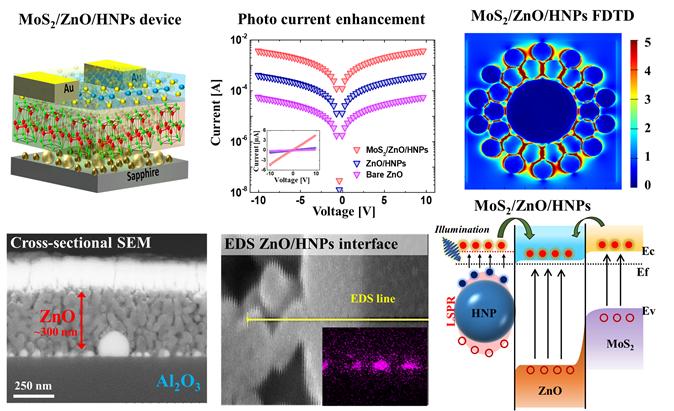Prof. Lee Jihoon’s Research Team Develops a Zinc Oxide Quantum Dot-Based Photodetector With Signi...
- admin
- 2021-11-18
- 3230
Professor Lee Jihoon’s Research Team Develops a Zinc Oxide Quantum Dot-Based Photodetector With Significantly Improved Photoreactivity

Prof. Lee Jihoon's research team in the Department of Electronic Engineering and Ph.D. researcher, Rutuja (first author) of the Department of Electronic Engineering and Researcher (first author) made metasurface plasmon-based palladium-silver hybrid nanoparticles (PdAg HNP) and molybdenum disulfide nanoflakes (MoS2 NF) and a UV photodetector hybrid architecture incorporating zinc oxide quantum dots (ZnO QDs). The hybrid MoS2/ZnO/HNP photodetector exhibited a photocurrent of 4 × 10-3A under 10V, 3855nm, 54.9 mW/mm2 light irradiation, which is more than 100 times more efficient than the photocurrent of the ZnO QD photodetector. The proposed MoS2/ZnO/HNP hybrid ultraviolet (UV) photodetector showed excellent performance with improved rise and fall times on the order of a few seconds.
Ultraviolet (UV) photodetection is closely related to our daily life. Adequate UV exposure promotes vitamin D synthesis to prevent rickets, while excessive UV exposure can lead to various diseases such as cataracts, skin aging and skin cancer. In addition, crop yield and the lifespan of buildings are also greatly affected by UV irradiation. Ultraviolet (UV) photodetectors are being studied for various applications such as environmental monitoring, pollution monitoring, biochemical analysis, flame detection, inter-satellite communication, factory automation, missile launch detection, and optical communication.
The latest ultraviolet (UV) photodetectors require high sensitivity, fast response, and low cost, and various materials and device structures are currently being studied. Traditionally, ultraviolet (UV) photodetectors based on wide bandgap semiconductors such as GaN, ZnO, TiO2 and heterojunctions have been mainly developed. The composition shows great potential. Due to their wide semiconductor bandgap, good electrical properties, chemical stability and relatively low cost, zinc oxide quantum dots (ZnO QDs) are one of the most promising materials.

Photo description: Schematic of MoS2 nanoflakes (NF)/ZnO quantum dots (QD)/PdAg hybrid nanoparticles (HNP), i.e. MoS2/ZnO/HNP hybrid photodetector architecture. Photoresponse of various devices (10 V for 385 nm illumination at 54.9 mW/mm2). MoS2/ZnO/HNP hybrid FDTD simulation. Cross-section analysis of MoS2/ZnO/HNP hybrid devices. Schematic diagram of charge transfer and photocurrent enhancement in a hybrid MoS2/ZnO/HNP photodetector architecture.
The palladium-silver hybrid nanoparticle (PdAg HNP)-based UV photodetector was able to significantly improve the photoreactivity by incorporating semiconductor quantum dots and plasmonic nanostructures. In particular, palladium-silver hybrid nanoparticles (PdAg HNP) can exhibit strong electromagnetic fields on the surface and generate hot carriers upon UV irradiation due to localized surface plasmon resonance (LSPR), where absorption and scattering can be enhanced at specific wavelengths. , which is extracted by adjacent semiconductor layers. The MoS2/ZnO/HNP hybrid photodetector architecture could provide a promising approach to extract incident photons from metallic NP-semiconductor systems.
The improved performance of the MoS2/ZnO/HNP hybrid photodetector architecture is attributed to the efficient utilization of metasurface plasmon resonance (LSPR) induced hot carriers as well as photons scattered from plasmonic HNPs fully encapsulated by a layer of photoactive zinc oxide quantum dots (ZnO QDs). do. In addition, the addition of molybdenum disulfide nanoflakes (MoS2 NF) could provide an additional photon absorption pathway. The proposed MoS2/ZnO/HNP hybrid device structure demonstrates the integration of photon absorption and carrier transport properties of plasmonic HNPs, MoS2 NFs and ZnO QDs for enhanced ultraviolet (UV) photoresponse, with significantly higher performance compared to conventional UV photodetectors.
The researchers of this study are Rutuja Mandavkar (Ph.D. program, Kwangwoon University - first author), Rakesh Kulkarni (Ph.D. program, Kwangwoon University), Shusen Lin (Ph.D , Kwangwoon University), Md Ahasan Habib (Ph.D., Kwangwoon University), Puran Pandey (Ph.D., Kwangwoon University), So Hee Kim (Researcher, KIST Korea Institute of Science and Technology), Ming-Yu Li (Professor, Wuhan Institute of Technology), Sundar Kunwar ( Ph.D., Kwangwoon University), Jihoon Lee (Professor, Kwangwoon University - corresponding author), conducted as an international joint research. Student Rutuja Mandavkar entered Kwangwoon University as a Ph.D. in Electronics in 2020 and is currently a researcher in the second year of the doctoral program. She has participated in a number of joint studies to date and has published a number of co-author papers. First, she was happy that the first author's thesis was published in an excellent journal, and she expressed her ambition to continue her research at an excellent institution after obtaining his doctorate.
Meanwhile, this research was carried out with the support of Kwangwoon University and the National Research Foundation of Korea and the Ministry of Education, BK-21, and key research institutes. (Q1 MATERIALS SCIENCE, COATINGS & FILMS, IF: 6.707) published in the online edition of October 20, 2021 under the title “Dual-Step hybrid SERS scheme through the blending of CV and MoS2 NPs on the AuPt core-shell hybrid NPs”
* Web link: https://doi.org/10.1016/j.apsusc.2021.151739